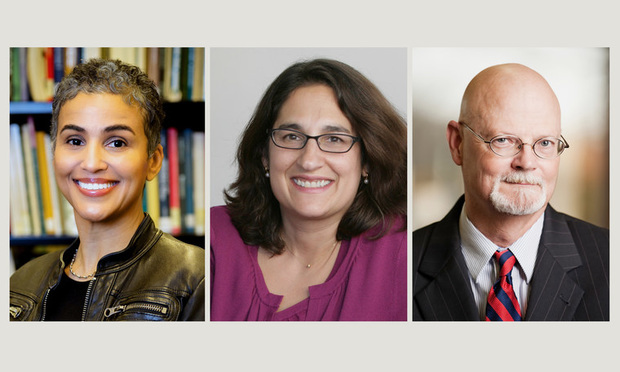The Big Fail Part II: Law Schools Clamber to Raise Bar Pass Rates
As part of Law.com's series on the high rate of bar exam failure, we examine the steps law schools are taking to fix the problem.
April 21, 2019 at 05:00 PM
9 minute read
 Renee Hutchins, Susan Freiwald and Thomas Geu.
Renee Hutchins, Susan Freiwald and Thomas Geu.
Two years ago, the bar pass rate for first-time test takers at the University of the District of Columbia David A. Clarke School of Law sank to 38 percent. Although the school has never had a particularly high first-time pass rate, the plunge to less than 40 percent was a red flag for administrators.
“We have taken this as seriously as a heart attack, because it's that important,” said Katherine “Shelley” Broderick, who was dean at the time.
To help reverse the trend, the school introduced a myriad of initiatives, which included requiring those who take on leadership roles with student organizations to have a grade-point average of 2.5 or higher. Administrators worried that weaker students were devoting too much time to those groups at the expense of their bar preparation.
But incoming dean Renée Hutchins acknowledges that it will take far more than that to solve the school's bar exam woes—which they maintain is the law school's top priority—and she is hopeful that a multifaceted approach will soon tip the scales.
How to reverse sliding bar exam pass rates is a puzzle that law deans across the country are trying to solve. The national average score on the Multistate Bar Exam—the multiple choice portion of the exam—hit a 34-year low last July, and thousands of law graduates each year are failing to make the cut.
 Law.com analyzed the bar pass rates reported by schools to the American Bar Association between 2013 and 2017—the 2018 results weren't available when the numbers were crunched—and found that 35 of the 203 ABA-accredited law schools had pass rates decreases of more than 20 percent in those four years. Further, 42 of the ABA-accredited law schools saw their pass rate fall anywhere from 10 to 20 percent. (Still other schools, primarily the higher-ranked ones, have seen little change in their pass rates.)
Law.com analyzed the bar pass rates reported by schools to the American Bar Association between 2013 and 2017—the 2018 results weren't available when the numbers were crunched—and found that 35 of the 203 ABA-accredited law schools had pass rates decreases of more than 20 percent in those four years. Further, 42 of the ABA-accredited law schools saw their pass rate fall anywhere from 10 to 20 percent. (Still other schools, primarily the higher-ranked ones, have seen little change in their pass rates.)
There is plenty of debate about why pass rates have fallen, but most experts agree that the 36-percent decline in law school applicants between 2010 and 2016 played a major role. Many schools dipped deeper into their applicant pool and enrolled students with lower LSAT scores and undergraduate grades. Other elements such changing law school pedagogy and the rise of online bar exam preparation are also at play, they say.
Because the reasons for dropping pass rates are complex, schools are taking a variety of approaches to addressing the problem. Some schools are emphasizing the identification of students who need extra support early on—a trend National Conference of Bar Examiners president Judith Gundersen said has taken off in recent years. Others are hiring outside bar preparation providers to lead classes, or are making third-year bar preparation class mandatory. Some are encouraging professors to focus on bar exam topics during their courses and even retooling their curriculum to emphasize what is tested.
And many schools, including UDC, are trying elements of all those approaches. Located on a historically black college and university campus, UDC considers itself an “access” school, giving students with nontraditional backgrounds and lower LSAT scores the opportunity to pursue legal careers. Those students often need more than one try to pass the bar exam, but the school is aiming to up the percentage of students passing on the first try.
Administrators have rolled out numerous changes. New student orientation is now more focused on the rigors of law school, after a survey revealed that students weren't studying enough for classes.
Gone are most of the fun orientation activities, replaced by instruction on things like how to properly brief a case. UDC Law also administers a diagnostic test early on to help identify students who need additional academic support.
Part I of The Big Fail explores the reasons why bar pass rates across the country have dropped precipitously over the past five years. Read it here.
Starting in 2015, every UDC student is required to take a practice bar exam in both their first and second years, and now every third-year student must complete a bar preparation course where they practice writing essay questions.
The school bolstered its academic support department and reduced the size of its incoming class in light of the correlation between first-year grades and bar passage. The smaller classes allow faculty to give students more feedback, especially in the first year.
“It's a little bit of changing the culture,” Broderick said. “We were hearing from far too many students: 'You know, I'm just going to take the bar. I know I may not pass it the first time, but I'm going get used to it.' I'm like, 'Hello? That's not the way you approach the bar. It's like marriage. Better done once.'”
Those efforts are only beginning to bear fruit, given the three-year lag time between when students start law school and when they take the bar. UDC's combined first-time pass rate on the February and July 2018 bar exams was up nearly 7 percent from the previous year, to 45 percent, according to Hutchins.
'Crucial to the School'
Susan Freiwald is hoping that the University of San Francisco School of Law will soon see its bar pass rate improve as well. The school, where she is interim dean, saw its first-time bar pass rate drop from 75 percent in 2013 to 52 percent in 2017, landing it among the biggest decliners during that period.
“The bar exam is crucial to the school,” Freiwald said. “The students come to law school, largely, to be lawyers. They have to be able to pass the bar. It's essential that we get our bar pass up.”
To that end, San Francisco has restructured its first-year curriculum to place more emphasis on the core subjects tested on the bar. Starting in the fall of 2018 class including contracts, civil procedure and property went from four credits over one semester to six credits over two semesters, reversing an earlier change that had been made to allow students to take more electives.
The school has also made civil procedure mandatory and added a required legal drafting course intended to provide practice on bar exam essay questions. The school offers a variety of optional bar prep programs, as well as required academic counseling. However, it will take another three years to see if retooling the curriculum results in higher bar pass rates.
Freiwald cautioned she doesn't want to see the school focused solely on the bar exam at the expense of the many other facets of a solid legal education.
“You want to make sure they are getting practical skills they need to be good lawyers,” she said. “Clinics are important, elective are important. And of course we need to teach them to policies behind the law, and help them do pro bono work. You don't want to cut all that out just so they can pass the bar.”
Law School Admission Council president Kellye Testy said she, too, is concerned about some schools becoming overly focused on the bar exam.
“I worry that the very students who might need the most help in developing the critical thinking skills that being an effective lawyer requires have less time devoted to that now, and more time getting all the doctrine that the bar exam tests. They're probably picking bar exam classes over clinics and more rigorous classes such as securities regulation. I'm worried that we're giving less because we're focused so narrowly on bar skills.”
Precipitous Decline
A precipitous decline in the first-time in-state bar pass rate at the University of South Dakota School of Law also prompted administrators to rethink their approach to bar prep. That rate went from 98 percent in 2013 to 36 in 2017, before rising to 82 in July of 2018. (The state increased the exam cut score from 130 to 135 in 2015, then lowered it to 133.)
But that recovery has been painful. The school significantly decreased the size of its incoming class from about 70 to 50 in order to bring in students with higher credentials, which took a financial toll. The law school is essentially responsible for covering its own operating budget, so fewer students and tuition dollars mean fewer funds overall, said former dean Thomas Geu.
South Dakota has also instituted curricular changes and hired a full-time bar prep instructor. In 2017 it launched a mandatory bar preparation course in the third year, which was important to removing any stigma from students opting in—a sign to others that they may be struggling.
And a recent inquiry into whether the school should relocate to a larger city led the state and university to pledge a combined $600,000 to innovate the school's curriculum, and donors have stepped up to fund 15 full-ride scholarships, amounting to $650,000 annually. (The task force recommended against relocating.)
Those scholarships are helping the law school recruit students with higher LSAT scores and undergraduate grades, Geu said. He hopes that will help bring up the bar pass rate and keep talented local students from leaving South Dakota for law school.
It's the kind of turnaround that deans such as UDC's Hutchins and San Francisco's Freiwald are hoping for amid a larger shift in how legal education treats the bar exam.
“When I was in law school I don't remember a faculty member ever mentioning the bar exam and helping us prepare for that,” Hutchins said. “I don't think they viewed it as part of their role—whether we passed. That was like this thing that happened after law school, and it was disconnected from what we were learning. I think we as legal academy—and UDC—are getting a better understanding for the reality that bar passage is dependent on a structure, the three-year sequenced curriculum that helps students understand what the rules are.”
Data collection by Ben Hancock. Chart by David Palmer.
This content has been archived. It is available through our partners, LexisNexis® and Bloomberg Law.
To view this content, please continue to their sites.
Not a Lexis Subscriber?
Subscribe Now
Not a Bloomberg Law Subscriber?
Subscribe Now
NOT FOR REPRINT
© 2025 ALM Global, LLC, All Rights Reserved. Request academic re-use from www.copyright.com. All other uses, submit a request to [email protected]. For more information visit Asset & Logo Licensing.
You Might Like
View All

'A Death Sentence for TikTok'?: Litigators and Experts Weigh Impact of Potential Ban on Creators and Data Privacy

Skadden and Steptoe, Defending Amex GBT, Blasts Biden DOJ's Antitrust Lawsuit Over Merger Proposal
4 minute read
Amex Latest Target as Regulators Scrutinize Whether Credit Card Issuers Deliver on Rewards Promises
Trending Stories
- 1Courts Demonstrate Growing Willingness to Sanction Courtroom Misuse of AI
- 2The New Rules of AI: Part 1—Managing Risk
- 3Change Is Coming to the EEOC—But Not Overnight
- 4Med Mal Defense Win Stands as State Appeals Court Rejects Arguments Over Blocked Cross-Examination
- 5Rejecting 'Blind Adherence to Outdated Precedent,’ US Judge Goes His Own Way on Attorney Fees
Who Got The Work
J. Brugh Lower of Gibbons has entered an appearance for industrial equipment supplier Devco Corporation in a pending trademark infringement lawsuit. The suit, accusing the defendant of selling knock-off Graco products, was filed Dec. 18 in New Jersey District Court by Rivkin Radler on behalf of Graco Inc. and Graco Minnesota. The case, assigned to U.S. District Judge Zahid N. Quraishi, is 3:24-cv-11294, Graco Inc. et al v. Devco Corporation.
Who Got The Work
Rebecca Maller-Stein and Kent A. Yalowitz of Arnold & Porter Kaye Scholer have entered their appearances for Hanaco Venture Capital and its executives, Lior Prosor and David Frankel, in a pending securities lawsuit. The action, filed on Dec. 24 in New York Southern District Court by Zell, Aron & Co. on behalf of Goldeneye Advisors, accuses the defendants of negligently and fraudulently managing the plaintiff's $1 million investment. The case, assigned to U.S. District Judge Vernon S. Broderick, is 1:24-cv-09918, Goldeneye Advisors, LLC v. Hanaco Venture Capital, Ltd. et al.
Who Got The Work
Attorneys from A&O Shearman has stepped in as defense counsel for Toronto-Dominion Bank and other defendants in a pending securities class action. The suit, filed Dec. 11 in New York Southern District Court by Bleichmar Fonti & Auld, accuses the defendants of concealing the bank's 'pervasive' deficiencies in regards to its compliance with the Bank Secrecy Act and the quality of its anti-money laundering controls. The case, assigned to U.S. District Judge Arun Subramanian, is 1:24-cv-09445, Gonzalez v. The Toronto-Dominion Bank et al.
Who Got The Work
Crown Castle International, a Pennsylvania company providing shared communications infrastructure, has turned to Luke D. Wolf of Gordon Rees Scully Mansukhani to fend off a pending breach-of-contract lawsuit. The court action, filed Nov. 25 in Michigan Eastern District Court by Hooper Hathaway PC on behalf of The Town Residences LLC, accuses Crown Castle of failing to transfer approximately $30,000 in utility payments from T-Mobile in breach of a roof-top lease and assignment agreement. The case, assigned to U.S. District Judge Susan K. Declercq, is 2:24-cv-13131, The Town Residences LLC v. T-Mobile US, Inc. et al.
Who Got The Work
Wilfred P. Coronato and Daniel M. Schwartz of McCarter & English have stepped in as defense counsel to Electrolux Home Products Inc. in a pending product liability lawsuit. The court action, filed Nov. 26 in New York Eastern District Court by Poulos Lopiccolo PC and Nagel Rice LLP on behalf of David Stern, alleges that the defendant's refrigerators’ drawers and shelving repeatedly break and fall apart within months after purchase. The case, assigned to U.S. District Judge Joan M. Azrack, is 2:24-cv-08204, Stern v. Electrolux Home Products, Inc.
Featured Firms
Law Offices of Gary Martin Hays & Associates, P.C.
(470) 294-1674
Law Offices of Mark E. Salomone
(857) 444-6468
Smith & Hassler
(713) 739-1250








